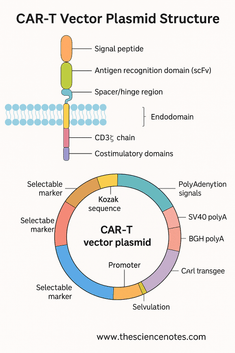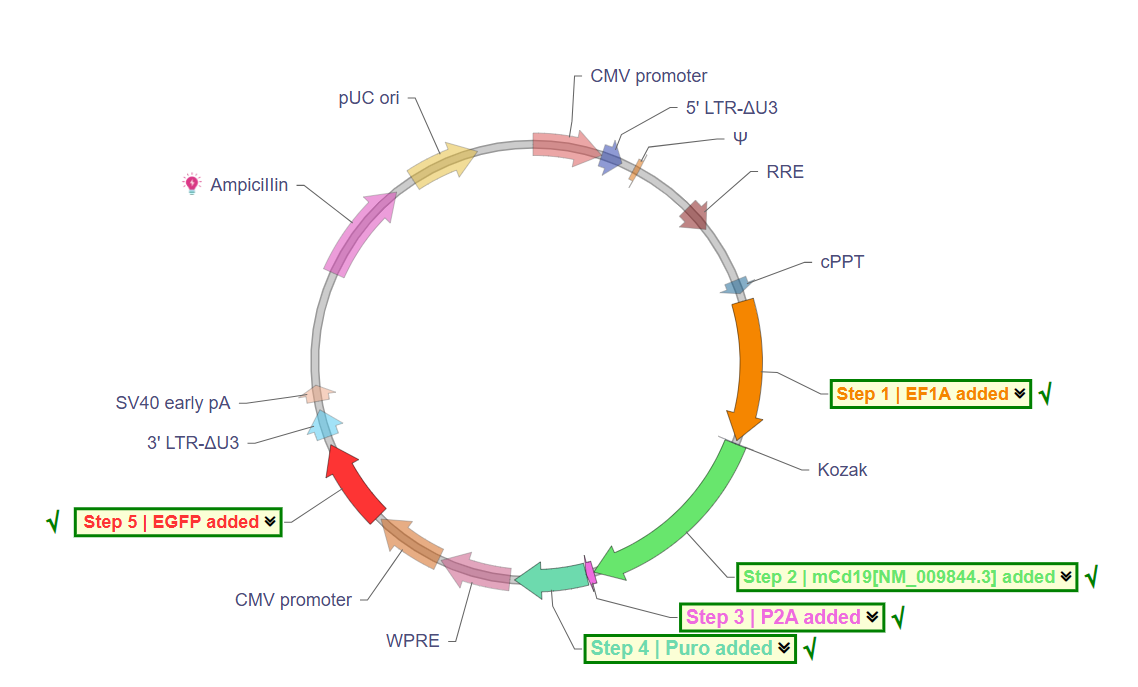Chimeric antigen receptor (CAR) T-cell therapy has revolutionized cancer therapy by exploiting the inherent ability of the immune system to specifically target and destroy malignant cells. This personalized therapeutic approach involves genetically engineering the patient’s own T cells to express synthetic receptors (CARs) that recognize tumor-specific antigens independent of the major histocompatibility complex (MHC). The heart of this technology is the CAR-T vector plasmids. It is a synthetic DNA construct that encodes CAR proteins and contains all the regulatory elements necessary to ensure proper expression and functionality within T cells.
Understanding the structural components of CAR-T vector plasmids is essential not only to optimize therapeutic efficacy and safety, but also to advance the field of cellular immunotherapy. This article provides a detailed investigation of the car structure itself and essential vector elements housed within the plasmid that allow for efficient car representation, selection and function.
1. Car Proteins: Modular Structure and Function
At the core of CAR-T therapy is the chimeric antigen receptor, a synthetic transmembrane protein that has the ability to recognize specific tumor-associated antigens in T cells and initiate a cytotoxic immune response. The car is modular and generally consists of three important domains.
-
Ectodomain (extracellular antigen recognition)
-
Transmembrane domain (membrane anchor)
-
Endodomain (intracellular signaling and activation)
Each domain is carefully designed to maximize T-cell specificity, activation, and persistence.
1.1 Ectodomain: Accurately target tumor antigens
The ectodomain protrudes from the T cell surface and mediates antigen recognition. It contains three important subcomponents:
a) Signal peptide
Signal peptides often derived from the CD8α leader sequence are short N-terminal amino acid sequences that direct early car proteins into the endoplasmic reticulum. This facilitates proper folding, glycosylation and transport to the cell surface. Without an effective signal peptide, CAR proteins cannot reach the membrane and are not effective in treating.
b) Antigen-binding domain (SCFV)
This domain grants target specificity. This is generally a single chain variable fragment (SCFV), a fusion of the variable regions of the heavy (VH) and light (VL) chains of monoclonal antibodies associated with flexible peptides. SCFV binds directly to tumor antigens on the cell surface independently of MHC presentation, allowing CAR-T cells to bypass the tumor immune evasion mechanism that downregulates MHC molecules.
The affinity and specificity of SCFV has a significant effect on treatment outcome. High affinity may improve target recognition, while excessively strong binding may cause activation-induced cell death or target toxicity. Furthermore, the location of the antigen and antigen density epitopes of tumor cells also affects the efficacy of CAR-T. In particular, the SCFV domain is prone to aggregation and can cause tonic (antigen-independent) signaling that leads to premature T-cell fatigue. Therefore, stable folding SCFVS is a continuous field of research.
c) Hinge or Spacer Area
The hinge region connects the SCFV to the transmembrane domain, providing structural flexibility, allowing the antigen-binding domain to reach and engage with target epitopes that may be sterically blocked. The length and composition of the spacer will have a major impact on the functioning of the vehicle.
Commonly used spacers include CD8α or CD28, or hinges for the IgG FC region (e.g. IgG1 or IgG4). IgG-derived spacers often have to be mutated to prevent interaction with FC gamma receptors (FCγRS) in innate immune cells. The length of the spacer should be adjusted to suit the specific antigenic epitope. Longer spacers promote access to membrane psinyl epitopes, but may increase tonic signaling and activation-induced cell death, while shorter spacers are more suitable for membrane vertical epitopes.
In addition to its functional role, spacers also function as epitopes for purification techniques such as antibody-based CAR detection and incorporation of strip-tag sequences.

1.2 Transmembrane Domain: Anchors and Stabilization
The transmembrane domain fixes the CAR to the T cell membrane and physically connects the extracellular recognition domain to the intracellular signaling module. Despite its small size, this domain affects vehicle expression levels, receptor stability, and signaling.
Transmembrane domains are often derived from natural T-cell proteins such as:
-
CD3ζ (CD247)
-
CD4
-
CD8α
-
CD28
The selection of transmembrane domains may affect the way CAR integrates with endogenous T-cell receptor (TCR) complexes. For example, the CD3ζ transmembrane domain may promote automotive integration into the native TCR complex, which may promote activation, but perhaps promote destabilizing receptor complexes. CD8α and CD28 transmembrane domains tend to lead to receptor stability and consistent surface expression. Furthermore, transmembrane domains may affect cytokine release profiles and tonic signaling. This is closely linked to safety and efficacy.
1.3 Intracellular Signaling Domain: Initiation of T-cell activation
The intracellular endodomain converts antigen recognition into T-cell activation and cytotoxic responses. This includes signaling motifs that cause proliferation, cytokine release and killing target cells.
a) CD3ζ chain
The CD3ζ chain is the main signaling domain in all vehicle designs. This includes three immune receptor tyrosine-based activation motifs (ITAMs), which when phosphorylated upon antigen binding, initiate a downstream signaling cascade that is essential for T-cell activation.
b) Costimulatory domain
To prevent T-cell function, persistence, and fatigue, one or more costimulatory domains upstream of CD3ζ are incorporated into the CAR.
-
CD28: It promotes rapid T-cell swelling and potent cytokine secretion, but may lead to shorter persistence.
-
4-1bb (CD137): It strengthens T cell survival and memory formation, contributing to sustained activity.
-
others: Combinations such as ICO, CD27, OX40, and MyD88 Plus CD40 are under investigation for optimized signaling.
Automotive generation is classified based on the complexity of the intracellular domain.
-
First generation cars: CD3ζ only.
-
Second generation car: CD3ζ and one co-stimulatory domain (most FDA-approved vehicles belong here).
-
Third generation cars: CD3ζ and two costimulatory domains for potentially enhanced functions.
2. CAR-T Vector Plasmid: Essential Genetics
The CAR transgene is embedded in plasmid vectors designed to maximize expression, stability, and selection ability during T cells and plasmid propagation.
2.1 Promoter: Drive car expression
Efficient transcription of the CAR gene depends on the selection of promoters that control the expression cassette. Common promoters are:
-
EF1α (elongation factor 1 alpha): A powerful and constitutive promoter that operates in a wide range of cell types, including T cells. It allows for stable, high-level expression without silencing.
-
CMV (cytomegalovirus) Immediate early promoter: Although it is a viral promoter with robust early expression, it can become silent over time in certain primary cells.
-
PGK (phosphoglycerate kinase) promoter: A weaker constitutive promoter used when moderate expression is desired to reduce tonic signaling or toxicity.
Promoter selection balances the need for adequate CAR proteins on the surface, minimizing the risk of excessive activation or fatigue.
2.2 Kozak Sequence: Optimize Translation Start
Just upstream of Start Codon (AUG), the Kozak Consensus sequence (GCCGCCACC), enhances ribosome binding and initiates efficient translation of CAR mRNA. Incorporation of optimized Kozak sequences is a standard practice for maximizing protein yield.
2.3 Polyadenylation Signal: Ensures mRNA stability
Following the CAR coding sequence, polyadenylation (POLYA) signals promote proper transcriptional termination, mRNA stability, and nuclear export. The two commonly used POLYA sequences are:
-
SV40 Late Polya: From Simian Virus 40, widely used in mammalian expression vectors.
-
bgh polya: Bovine growth hormone polydenylation sequences are equally effective in stabilizing transcripts.
Proper polyadenylation reduces degradation and promotes the production of automotive proteins.
2.4 Selectable markers and reporter genes
To identify and select transfected or transfected T cells, plasmids often contain markers such as:
-
Antibiotic resistance genes (eg, neomycin resistance): Allows antibiotic selection in cell culture.
-
Fluorescent proteins (eg, EGFP, MCHERRY): Enable visualization and sorting via flow cytometry.
-
Dual markers: Combines antibiotic resistance and fluorescence for flexible selection.
These elements are usually controlled by individual promoters and do not interfere with vehicle expression.
2.5 Origin of Replication (ORI)
Origin of replication such as plasmid propagation in bacteria puc ori Included. This allows for high copy duplication E. colipromotes large-scale plasmid production required for clinical and research purposes.
2.6 Bacterial Selection Markers
Ampicillin resistance gene (amp^r) It is used for antibiotic selection in bacterial cultures and ensures that only bacteria carrying the plasmid survive.

3. FDA approved Car-T products: Examples of real vectors
Several CAR-T cell therapies have been FDA approved, each using a different but fundamentally similar vector design.
| Trade name | Common Name | company | Approval date | Target antigen | Adaptation |
|---|---|---|---|---|---|
| kymriah™ | Tisagenlecleucel | Novartis | August 2017 | CD19 | Recurrence/Impact resistant B-All |
| yescarta™ | axicabtagene ciloleucel | Gilead/Kite | October 2017 | CD19 | Recurrence/Impact resistant DLBCL |
| tecartus™ | Brexucabtagene Autoleucel | Gilead/Kite | July 2020 | CD19 | Recurrent/impact-resistant mantle cell lymphoma |
| Breyanzi® | Lisoka Tagen Mala Lessel | Bristol Myers Squibb | February 2021 | CD19 | Large recurrence/impact resistant B-cell lymphoma |
| Abecma® | Idecabtagene Vicleucel | Bristol Myers Squibb | March 2021 | BCMA | Recurrent/refractory multiple myeloma |
| carvykti® | Siltakabutagen Autoholeucel | Jansen | February 2022 | BCMA | Recurrent/refractory multiple myeloma |
These products illustrate how modular vehicle and vector designs fit to target a variety of antigens and diseases, while maintaining the core plasmid backbone architecture.
https://www.cancer.gov/about-cancer/treatment/research/car-t-cells
4. Summary remarks: The future of Car-T vector design
Car-T vector plasmids are more than just a simple DNA delivery vehicle. It is a complex, finely tuned genetic tool essential for successful CAR-T cell therapy. Each component selects the affinity of SCFV and spacer length, to the transmembrane and signaling domains, and affects treatment outcomes, from promoter strength and selection markers.
Although first and second generation cars have achieved notable clinical success, the ongoing challenges include antigen escape, T-cell fatigue and toxicity. These issues highlight the need for improved vector designs, including inducible promoters, new costimulatory domains, optimized SCFVs, and safety switches.
As CAR-T therapy expands beyond hematologic malignancies to solid tumors and other diseases, vector plasmids must evolve with sophisticated regulatory elements and finely tuned car architectures to meet new challenges. Enhanced high-throughput screening and computational design tools accelerate this development and ultimately improve patient efficacy, safety and accessibility worldwide.







